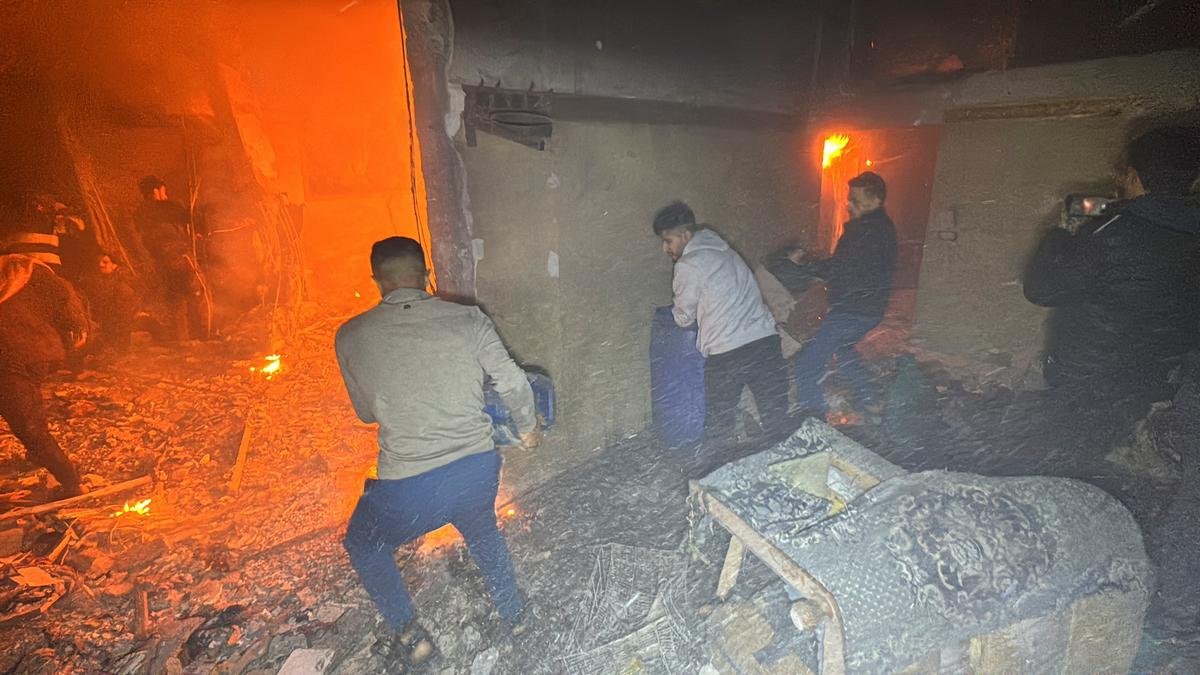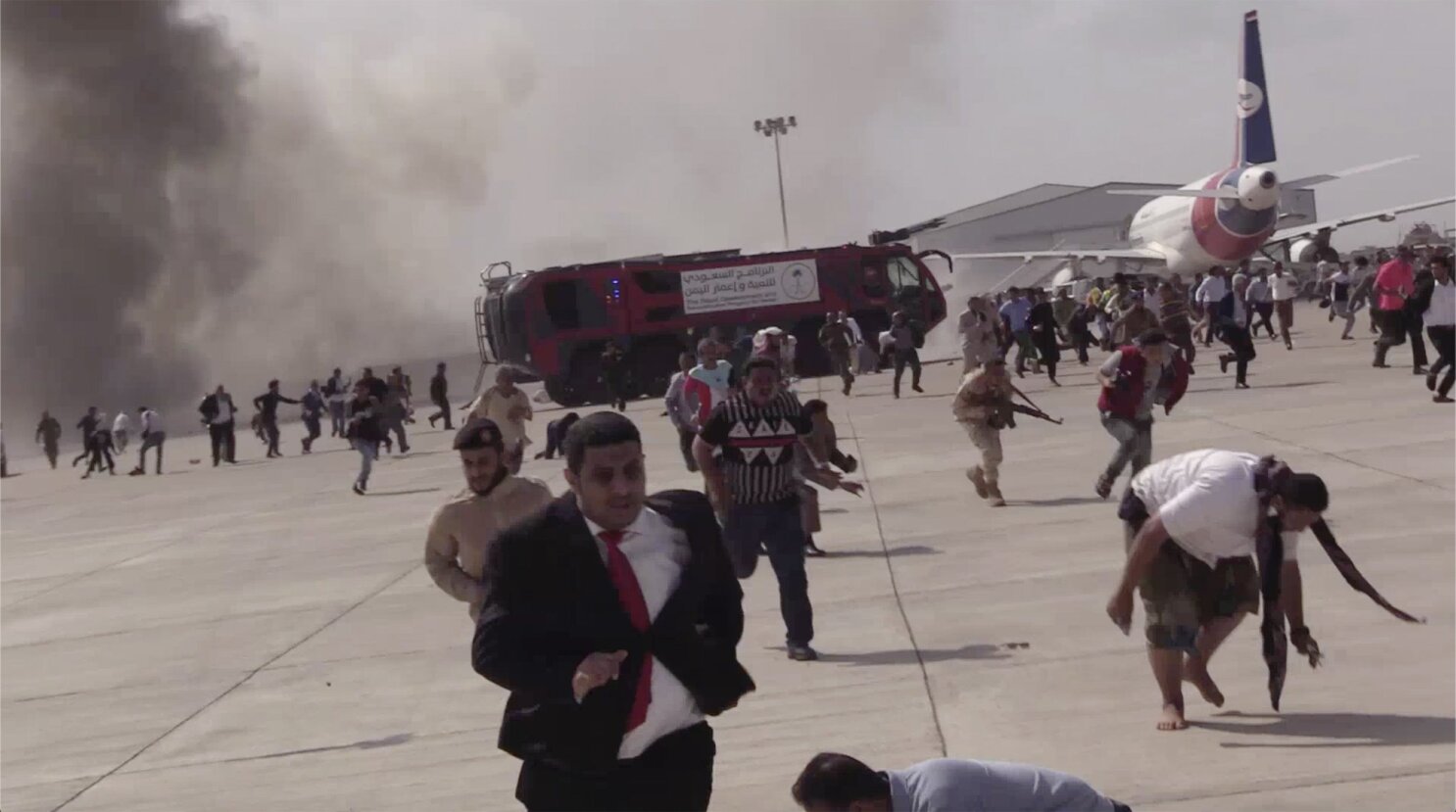Politics
Israel’s Massive Attacks. Gaza: Kamal Adwan Hospital Stormed, Burned, And Destroyed By “Robots” And Yemen Airport Bombed As Airbus 320 With Hundreds Of Passengers Was Landing
Published
10 months agoon

The Israeli military has launched a devastating attack on Kamal Adwan Hospital, the last remaining operational medical facility in northern Gaza. The assault has left the hospital in ruins, its wards burned, and its critical medical departments—including operating rooms and emergency units—completely destroyed.
The Gaza Health Ministry reports that dozens of hospital staff, including the hospital director Dr. Hussam Abu Safia, were forcibly taken by Israeli forces for interrogation. The fate of the evacuated patients, including those in critical condition, remains unknown as the hospital was forcibly cleared.
An estimated 350 individuals, comprising patients, staff, and others seeking refuge, were forced to evacuate. Communication with the facility has been severed, plunging the area into further chaos.
Witnesses on the ground reported that the Israeli military employed advanced “robotic” technology in the attack. According to these accounts, remotely-operated armored vehicles were used to deliver explosive devices, which detonated with devastating force, causing significant casualties among patients and medical personnel.
The Use of “Robot Bombs” in Gaza
Israeli media outlet Ynet has confirmed that the military has deployed a new tactic involving old M-113 armored personnel carriers (APCs) repurposed as explosive-laden vehicles. These APCs are remotely controlled and driven to suspected Hamas positions, where the explosives are detonated to clear the way for advancing infantry.
Footage circulating on social media shows one such APC delivering a box marked “danger” outside Kamal Adwan Hospital, which subsequently exploded, sending shrapnel flying and injuring several individuals. The same tactic was reportedly used to target multiple areas within the hospital, exacerbating the destruction and chaos.
Medical sources have revealed harrowing details of the attack, stating that at least five staff members were burned alive after Israeli forces set fires in different parts of the hospital. Local authorities have condemned the raid as “barbaric” and accused the Israeli military of deliberate war crimes against civilians and medical personnel.
In response, the Israeli military released a statement claiming that Hamas was using the hospital as a stronghold for military activities. However, such claims have been made in previous conflicts without substantive evidence.
Historical Context.
The destruction of Kamal Adwan Hospital brings haunting echoes of the 2023 raid on Al-Shifa Hospital, where Israeli forces alleged that Hamas used the facility as a command center. To this day, no evidence has substantiated these claims, raising concerns about the justification for such devastating assaults on critical health infrastructure.
Kamal Adwan. A Lifeline Cut Off
Kamal Adwan was the last operational hospital in northern Gaza, though it was barely functional due to the crippling siege imposed by Israeli forces. This siege has restricted food, water, and medical supplies, leaving the hospital struggling to meet even the most basic needs.
Reports indicate that the explosions at Kamal Adwan Hospital were so powerful that shockwaves were felt as far away as Tel Aviv. The sheer scale of destruction underscores the intensifying brutality of the conflict.

UN and WHO Condemn “Systematic Dismantling” of Gaza’s Health System
The World Health Organization (WHO) has strongly condemned the attack on Kamal Adwan, describing Israel’s actions as the “systematic dismantling” of Gaza’s health system. WHO warns that this destruction amounts to a “death sentence” for tens of thousands of Palestinians.
The United Nations Relief and Works Agency for Palestine Refugees (UNRWA) has also called for the immediate flow of humanitarian aid, as babies and vulnerable populations are freezing to death amidst the chaos.
“This Horror Must End”
In a statement issued on Friday night, the WHO expressed deep concern for the safety of 60 health workers and 25 critically ill patients who remained in the hospital, including those reliant on ventilators. Many patients in moderate to severe condition were forced to evacuate to the non-functional Indonesian Hospital, further endangering their lives.
“This raid on Kamal Adwan Hospital comes after escalating restrictions on access for WHO and partners, and repeated attacks on or near the facility since early October,” the statement read.
The WHO emphasized that such actions have undone all efforts to maintain even minimal functionality at the hospital, calling for an immediate ceasefire and protection for healthcare facilities.
Since the escalation of the conflict, at least 45,436 Palestinians have been killed, with 108,038 wounded. Meanwhile, the initial Hamas-led attack on October 7 claimed the lives of 1,139 Israelis, with over 200 individuals taken captive.
Devastation in Sheikh Radwan. No Intact Bodies Found After Airstrike
Meanwhile, the relentless assault on Gaza City’s Sheikh Radwan neighborhood reached a horrifying new low on Friday; the grim aftermath of an Israeli airstrike that left no single intact body behind.
“Since the early morning, we have been working without tools or equipment, using only our hands to pull out remains—not even whole bodies,” Halawa said. “We are collecting pieces of human flesh so that they won’t be eaten by cats and dogs. We haven’t found a single intact body. They are all human remains—little children and women.”
Emergency workers later confirmed the recovery of the remains of 15 people from the rubble of a house where 40 displaced individuals had been sheltering.

Palestinians Freezing to Death on Gaza’s Coast
Amid the bombardments, displaced Palestinian families endure freezing temperatures along the desolate beach in central Gaza’s Deir el-Balah. They live in makeshift tents that offer no protection from the biting winter cold.
Jan Egeland, secretary-general of the Norwegian Refugee Council (NRC), called the deaths of infants from hypothermia a “man-made catastrophe.” In a poignant statement, Egeland said:
“We warned of this many times: the Israeli strangulation of Gaza, where neither shelter nor food reach the innocent, has led to babies freezing to death. This catastrophe is man-made from A to Z.”
Children Dying as Temperatures Plummet
At least four Palestinian infants have succumbed to the cold in recent days, victims of the harsh winter and the blockade that prevents essential supplies from reaching the besieged territory.
The crisis claimed the life of a healthcare worker, Al-Hakim Ahmed al-Zaharneh, whose body was discovered in his tent in the al-Mawasi area. He died from hypothermia while working at the European Gaza Hospital, according to Gaza’s Health Ministry.
Hundreds of thousands of Palestinians are now living in flimsy tents and makeshift shelters, with no means to stay warm. As the cold tightens its grip, the warnings from humanitarian organizations have turned into tragic realities.

Escalation in Yemen. Israel Bombs Yemen’s Main Airport and Port City
Likewise, the conflict in the Middle East has taken a dangerous turn as Israeli forces launched renewed airstrikes on Yemen, targeting key civilian infrastructure. On Thursday, Israeli warplanes bombed Yemen’s main international airport in Sanaa, even as a civilian Airbus 320 with hundreds of passengers onboard was landing.
Israeli Prime Minister Benjamin Netanyahu warned of more strikes to come following the attack. In response, Houthi forces fired another missile at Tel Aviv, intensifying the already volatile situation.
A Near Catastrophe at Sanaa Airport
Julien Harneis, the UN’s top humanitarian official in Yemen, described the attack as “frightening.” The airport’s control tower was destroyed during the strikes, leaving the landing of the Yemenia Airways plane fraught with danger.
“Fortunately, the plane was able to land safely, and the passengers disembarked, but it could have been far, far worse,” Harneis said. He and WHO Director-General Tedros Adhanom Ghebreyesus were in the airport lounge when the airstrikes occurred.
A crew member from the UN Humanitarian Air Service suffered a severe leg injury from shrapnel during the strikes. Despite significant blood loss, he was later flown to Jordan for treatment, alongside Tedros and other UN personnel.
Tedros: “We Narrowly Escaped Death”
Tedros Adhanom Ghebreyesus shared harrowing details of the attack, revealing how close the UN delegation came to tragedy.
“I was not sure I could survive because it was so close, a few meters from where we were,” Tedros told Reuters. “A slight deviation could have resulted in a direct hit.”
Tedros described the aftermath: a damaged airport, missile fragments scattered across the terminal, and the sound of drones overhead fueling fears of further strikes.
The WHO chief expressed shock that a civilian airport, especially one with a publicized itinerary of humanitarian travel, would be targeted.
“A civilian airport should be protected, whether I am in it or not,” he stated, emphasizing the broader implications of the strike. Tedros reflected on the ordeal: “One of my colleagues said we narrowly escaped death. I’m just one human being. I feel for those who face this every single day. But at least it allowed me to feel the way they feel.”
The strike on Sanaa’s airport gives a peek into the intensifying conflict in Yemen, with civilians and humanitarian workers caught in the crossfire.
The Last Bit
The situation in Gaza is dire. Bombings continue to tear apart families and neighborhoods, while the winter cold delivers a slow, relentless death to those who survive the explosions. Entire families, including the youngest and most vulnerable, are caught in a nightmarish reality with no end in sight.
Meanwhile, the strike on Sanaa’s airport illustrates the intensifying conflict in Yemen, with civilians and humanitarian workers caught in the crossfire.
The international community now faces mounting pressure to intervene and prevent further loss of life in a region already grappling with one of the world’s worst humanitarian crises.
